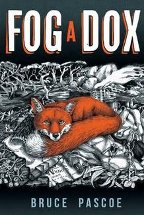Fog a dox by Bruce Pascoe

Magabala Books, 2012. ISBN 978 1 921248 55 9
(Ages: 11+) Highly recommended. Animals. Wilderness. With the
gentle accumulation of story and setting, the tale of Albert's dogs,
and particularly the fox cub which he takes into this home, reads
like a fable. Albert is a timber getter, living alone in the bush,
felling tress, splitting logs, surviving the winter cold as best he
can. His part dingo bitch, Brim, has pups which many in the area
value, and each time she has a litter he has no problem in getting
each pup a good home. But when he brings home three fox cubs,
rescued from their den after their mother was probably taken by a
hawk, they are reared alongside the pups, the two females leaving
early to set up their own dens, the third, the male, staying on.
Albert calls this a dox, so that people in the area get used
to it being around, and not want to kill it. And one day the fox
repays the favour, going to the neighbour's house to fetch Dave when
Albert's arm is trapped in a log being split.
Through the story we hear of a young girl, Maria, dying of leukemia,
having to spend her days watching the Discovery Channel, getting
more and more interested and knowledgable about the animals she
sees. Eventually the two stories come together, the lonely men in
the wild with their dogs and a fox, and the young dying girl in the
hospital, desperate to be outside.
The setting is marvellous, the thickly timbered mountains region of
south eastern Australia immediately comes to mind, with the weather
closing in, the numbing cold of the winer days and nights, the
isolation of the other timber getters, within walking distance, but
rarely seeing each other, preferring to keep by their own hearths,
with their own dogs as company. These men rely on their dogs for
friendship, something to talk to, something to keep the small of
their back warm at night. Pascoe's seemingly simple writing style
invites the reader into the world he reveals, one with which he must
be very familiar, one he holds in his mind fondly. His Aboriginal
heritage comes through clearly in his understanding of the bush, and
his inclusion of some Aboriginal words adds another layer of
meaning to the story. A tale of friendship and trust, this story is
redolent of the Australian bush, of the hardship endured by people
who chose to work alone, of their coming together through adversity.
At 100 or so pages, the detail given is quite extraordinary and the
story itself, mesmerising.
Fran Knight